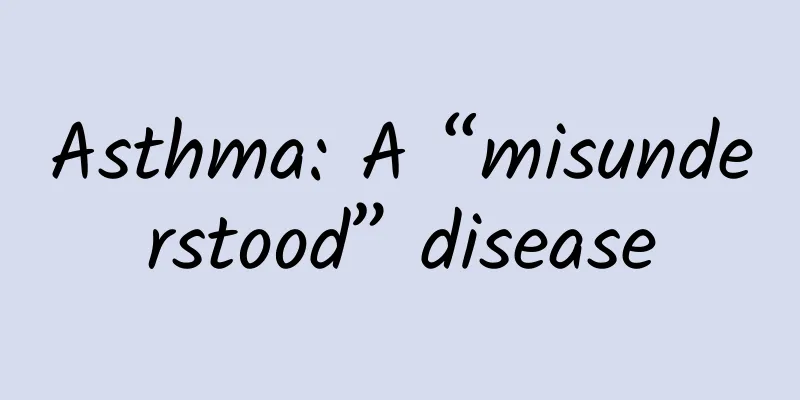Asthma: A “misunderstood” disease

|
Asthma is a common respiratory disease, but it is also a disease that has long been "misunderstood" by patients or their families. If these "misunderstandings" are not resolved, they will directly affect the treatment effect of the disease. For this reason, many patients still have repeated asthma attacks even though they have been treated, which is very troublesome! Misconception 1: Coughing without wheezing is not asthma. Many people mistakenly believe that asthma must have symptoms of wheezing, but this is not the case. There is a special type of asthma, cough variant asthma, which has chronic cough as the main or only clinical manifestation. Patients may not have obvious symptoms of wheezing or shortness of breath, but have airway hyperresponsiveness. GINA (Global Initiative for Asthma) has clearly stated that cough variant asthma is a form of asthma, and its pathophysiological changes are the same as those of asthma, namely persistent airway inflammation and airway hyperresponsiveness. Therefore, if a cough does not heal for a long time, it must be differentiated from asthma and requires professional medical diagnosis and treatment in the hospital. Misunderstanding 2: Asthma is an airway inflammation, so why can’t antibiotics be used for it? The airway inflammation of asthma refers to chronic inflammation involving multiple non-infectious cells, rather than inflammation caused by bacterial infection. Therefore, asthma cannot be treated with antibiotics, but anti-inflammatory drugs are usually used to inhibit inflammatory factors for treatment. Misconception 3: Take medicine only when symptoms occur. Asthma treatment must adhere to long-term and standardized medication. Asthma airways have long-term chronic inflammation. Long-term regular treatment can effectively improve asthma symptoms and suppress the level of airway inflammation. If you stop taking the medicine without authorization, especially if you stop treatment when the symptoms disappear, the airway inflammation will not be relieved, which will lead to worsening inflammation and repeated asthma attacks. Misconception 4: Follow-up visits are troublesome, so you don’t need to see a doctor if you don’t have any symptoms recently. Asthma conditions can change, resulting in the need to adjust medication regimens based on the condition. In order to achieve better symptom control and avoid asthma attacks, each patient must upgrade or downgrade treatment based on the situation, with the goal of finding the lowest dose that can control symptoms. Usually after the start of treatment, follow-up visits are required every 2 to 4 weeks, and then every 1 to 3 months. If an acute attack occurs, a follow-up visit is required within 1 week. Misconception 5: If you don’t have any symptoms, you don’t need to bring medicine when you go out. Here we need to remind everyone that even patients with mild symptoms are at risk of acute attacks, which can lead to serious harm. It is recommended that every asthma patient should have an asthma reliever and carry it with them to prevent asthma attacks. Commonly used relievers include: budesonide formoterol powder inhaler, terbutaline sulfate nebulizer, salbutamol sulfate, ipratropium bromide aerosol, etc. Misconception 6: Injections and medications work faster than inhaled medications. Compared with intravenous injection and oral administration, inhaled drugs reach the lungs directly through the respiratory tract after use, have a faster onset of action and better efficacy. Since less drugs enter the blood circulation, adverse reactions are relatively few. In addition, inhaled drugs are easy to carry and use, and can be inhaled and taken at any time. Misunderstanding 7: Inhaled medications contain hormones, which I heard have side effects, so it’s better to use them less. my country's authoritative guidelines point out that it is safe for patients to inhale inhaled corticosteroids within the clinically recommended dosage range. The combination of inhaled corticosteroids and bronchodilators is currently the first choice for asthma treatment. Glucocorticoids can effectively fight inflammation, while bronchodilators can quickly and long-term dilate the bronchi. They can be used as both control drugs and relieve drugs. They are currently the first choice for the treatment of asthma in patients aged 12 years and above. |
>>: Cold and cough that won’t go away? Learn about the nine respiratory tract items!
Recommend
How long after a meal can you exercise? Is it good to take a walk after a meal? Why can't you exercise right after a meal?
It is not advisable to run or exercise after a me...
What plant is the cashew nut a fruit of? Why are cashew nuts not in the shell?
Cashew is an evergreen tree or shrub. Its nuts ar...
Can you get pregnant the day after your period?
Many women only know that it is easy to get pregn...
How can pregnant women get rid of stretch marks?
Stretch marks are skin abnormalities that appear ...
How to decorate the background wall without ceiling? Decoration design skills of the background wall without ceiling
We all know that there are many options for house...
Causes of uterine contractions during pregnancy at 35 weeks
Pregnancy is a lifelong event for women. If there...
How many months of pregnancy will you have milk
Due to the changes in hormones in pregnant women&...
How many kidneys does a woman have?
Every organ in the body plays a vital role. The k...
Can I have an abortion at 2 months of pregnancy?
In daily life, many women suffer from menstrual d...
What are the symptoms of low back pain when you are pregnant?
Any mother who has ever been a mother can underst...
The elderly in the family are suffering from "yang phobia". How should children guide them to resolve the problem?
Recently, with the optimization and adjustment of...
What causes leg pain during menstruation?
Female friends will bleed when they have their pe...
Can you have sex on the day your period is over?
Whether from the perspective of men or women, you...
What should girls prepare for mountain climbing?
Mountain climbing is an outdoor sport that many f...









